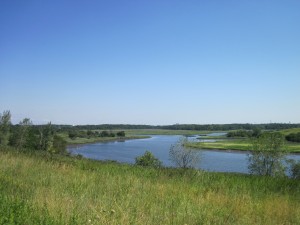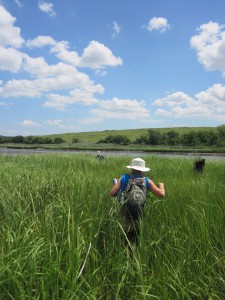From Behind the Mounds: Summertime in the Salt Marsh
2,200 total acres. 990 acres of former landfill. Last garbage barge in 2001. 150 million tons of garbage. Located along the Arthur Kill, Great Fresh Kill, Richmond Creek and Main Creek.
No, it didn’t matter how many facts I tried to memorize in preparation for my internship with Freshkills Park, because nothing can really prepare you for your first site visit. The simultaneous serenity and excitement of kayaking new waterways, the sensory stimulation of hearing insects and countless species of birds bustling around you, feeling dozens of grass species sweeping the sweat from your arms and face, watching dozens of fiddler crabs scatter around your feet as you carefully step past them… The list goes on and on, but the most awe-inspiring thing about Freshkills lies within the history of the site and the epic comeback that advocacy, passion, time and money have propelled. Formerly the world’s largest landfill, Freshkills Park is shaping up to be one of New York City’s largest parks and in my opinion, an invaluable example of park planning.
 Tasked with monitoring the environmental conditions at the North Park Restoration site, I have viewed Freshkills Park through a scientific lens over the last twelve weeks. Sure, the final product will include some more traditional park amenities such as bike and pedestrian paths, sports fields, and areas to sunbathe and picnic, but I believe what makes Freshkills Park unique is the vast space set aside for natural settings and the restoration to critical tidal wetland ecosystems taking place there. During casual conversations with visitors to the park’s Discovery Day on August 9th, I asked Staten Island natives what the place was like ten, fifteen, twenty years ago. Among wide eyes, raised brows, and smirked lips all answers were the same, “A dump!” Back then, I don’t think anybody would have associated “Freshkills”with the white egrets, great herons, red tailed hawks, white tailed deer, muskrats, fiddler crabs, snails, or butterflies that roam the site today.
Tasked with monitoring the environmental conditions at the North Park Restoration site, I have viewed Freshkills Park through a scientific lens over the last twelve weeks. Sure, the final product will include some more traditional park amenities such as bike and pedestrian paths, sports fields, and areas to sunbathe and picnic, but I believe what makes Freshkills Park unique is the vast space set aside for natural settings and the restoration to critical tidal wetland ecosystems taking place there. During casual conversations with visitors to the park’s Discovery Day on August 9th, I asked Staten Island natives what the place was like ten, fifteen, twenty years ago. Among wide eyes, raised brows, and smirked lips all answers were the same, “A dump!” Back then, I don’t think anybody would have associated “Freshkills”with the white egrets, great herons, red tailed hawks, white tailed deer, muskrats, fiddler crabs, snails, or butterflies that roam the site today.
 At the North Park Restoration site, a 1.8 acre parcel on the eastern edge of North Mound along Main Creek, ecology integrity is floating smoothly with success. Among a plethora of vegetative, macro faunal and benthic species, there have been important increases in the population density of Spartina Alterniflora, smooth cord grass- up 2.5% in the last two post-restoration years, and the accompanying Geukensia demissa, ribbed mussel- up 93% within the first post-restoration year, which are vital to healthy estuarine environments. Positive native plant growth prevents erosion and these benthic invertebrates work to filter toxins from, and release healthy nutrients into, tidal waters. And this isn’t just good news for the waterfowl- as coastal flooding events have harsher impacts on the built environment, the importance of wetlands as storm surge protectors is rising with high tide. Interested in visiting the North Park Restoration site? Check the calendar for kayak trips offered on the weekends that take you right past it via the waterways! Also, keep a look out for volunteer events in the coming years.
At the North Park Restoration site, a 1.8 acre parcel on the eastern edge of North Mound along Main Creek, ecology integrity is floating smoothly with success. Among a plethora of vegetative, macro faunal and benthic species, there have been important increases in the population density of Spartina Alterniflora, smooth cord grass- up 2.5% in the last two post-restoration years, and the accompanying Geukensia demissa, ribbed mussel- up 93% within the first post-restoration year, which are vital to healthy estuarine environments. Positive native plant growth prevents erosion and these benthic invertebrates work to filter toxins from, and release healthy nutrients into, tidal waters. And this isn’t just good news for the waterfowl- as coastal flooding events have harsher impacts on the built environment, the importance of wetlands as storm surge protectors is rising with high tide. Interested in visiting the North Park Restoration site? Check the calendar for kayak trips offered on the weekends that take you right past it via the waterways! Also, keep a look out for volunteer events in the coming years.
 Besides creating room for cramped city dwellers to run, play and breathe and for wildlife to fly, scurry, hunt and breed, the dedicated development staff at Freshkills Park is committed to connecting the public to the park as much as possible prior to the completion of the full 2,200 acres. Another challenging and hugely rewarding part of my summer was assisting withPark’s future ‘Live Tweeting Bird Boxes’. These cedar boxes will not only house the increasing populations of cavity nesting birds at the park, but also give you and me a sneak peek into the ecological revival that is happening on the ground and in the air. Each box will be outfitted with a single-board computer, motion sensor, and a camera. The sensor will send a signal to the computer whenever a bird enters or exits the box, which will then trigger the camera to take a picture and live tweet the picture to twitter along with a link to the live-feed video. All in all, I’d say Freshkills Park, staff, and this internship have been absolutely #Freshkillin’it. I’m sad to say goodbye but ecstatic to watch the park continue to evolve over the coming years.
Besides creating room for cramped city dwellers to run, play and breathe and for wildlife to fly, scurry, hunt and breed, the dedicated development staff at Freshkills Park is committed to connecting the public to the park as much as possible prior to the completion of the full 2,200 acres. Another challenging and hugely rewarding part of my summer was assisting withPark’s future ‘Live Tweeting Bird Boxes’. These cedar boxes will not only house the increasing populations of cavity nesting birds at the park, but also give you and me a sneak peek into the ecological revival that is happening on the ground and in the air. Each box will be outfitted with a single-board computer, motion sensor, and a camera. The sensor will send a signal to the computer whenever a bird enters or exits the box, which will then trigger the camera to take a picture and live tweet the picture to twitter along with a link to the live-feed video. All in all, I’d say Freshkills Park, staff, and this internship have been absolutely #Freshkillin’it. I’m sad to say goodbye but ecstatic to watch the park continue to evolve over the coming years.
-Eileen Munsch, Summer 2015 Environmental Monitoring Intern




